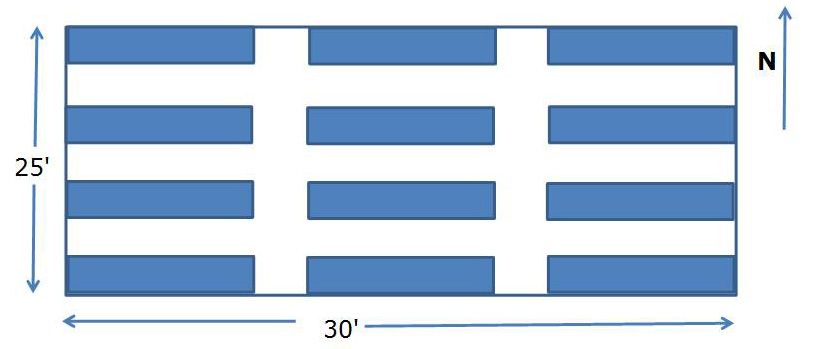Just what do I mean by “Plan Your Garden”? We already talked about the amount of sunshine needed, close to a water source and away from trees. What more do you need to plant seeds or transplants? Lots more; let’s get started.
How large is your garden bed? The National Garden Association reports the result of a survey that the average backyard garden is 750 square feet. That must have been some time ago. With newer neighborhood developments, backyards are smaller than they used to be and with zero lot lines, even smaller. A 750 square foot garden is about 25’ x 30’ in size. Take away the walking paths needed to get to vegetables growing in the garden bed, you lose about 270 square feet. This assumes the planting beds are 4’ wide and the walking paths are 3’ wide. Maybe you don’t want to walk a 25’ row but wish to divide your garden into 4’ x 8’ beds. You would then have 12 beds and lose an additional 150 square feet to more walking paths for a total of 384 square feet. The sketch that follows is not to scale but is used for illustrative purposes. There are now twelve, 4’ x 8’ garden beds (32 square feet each) in a 750 square foot garden.
How many vegetables can you plant in 32 square feet? That depends on how much room the mature vegetable plant needs to be most productive. Tomato plants require about four square feet per plant. In a 32 square foot bed, you could plant about six tomato plants. Squash plants require about nine square feet of space per plant. In a 32 square foot bed, you could plant about four squash plants. Carrot plants require about 2.5 square inches per plant. In a 32 square foot bed, you could plant a lot of carrots. The idea is for you to plan your garden needs, give the plants sufficient space to grow and produce well, and reduce waste.
Go ahead and make a sketch of your garden. Somewhere on the sketch, indicate the direction of North with an “N.” You will want to plant your tallest vegetables on the north side of the garden so you will not cast shadows on plants growing to the south side of those tall plants. Of course, corn is a tall plant. Pole beans, indeterminate tomatoes and cucumbers that will grow on trellises or other upright supports would be considered tall plants too. Do you have enough room for all the tall plants you want to grow?
Now that you know how big your garden is, you can plan the number of plants you actually need for each bed and reduce waste in the garden. If you need six tomato plants, then maybe you will grow eight seedlings into transplants and save the rest of the seeds for next year’s garden.
Which way do your orient the rows, North to South or East to West? In Central Florida it doesn’t make much difference. Choose whichever direction you want that fits into your vegetable garden plan.
Finally, you should plan for working outside. If you do not have garden tools then you should plan on obtaining hand tools, long handled tools (rake, shovel, hoe), a pair of gloves to protect your hands, close toed shoes (garden tools can accidentally cause damage to exposed toes), a watering can/garden hose with a 3’ wand and water break, plant labels, fertilizer, sterile growing media and seeds/transplants. These are all part of planning.
Now you are ready to start planting.
 0
0

